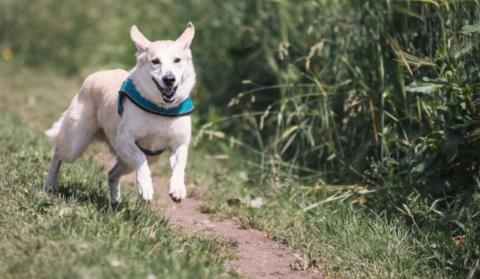
Published on August 21 by Lisa
For many dog owners, the idea of their dog roaming freely off-leash is a dream. The freedom, the trust, and the joy of seeing your dog run and play without restrictions can be incredibly rewarding. However, it’s essential that your dog is well-trained and reliable before allowing them off-leash to ensure their safety and the safety of others. Here are seven tips to help you train your dog to go off-leash safely.
Before even considering off-leash training, your dog should have a solid grasp of basic commands, especially “sit,” “stay,” “come,” and “leave it.” These commands are the foundation of off-leash control. If your dog doesn’t reliably respond to these commands while on a leash, they won’t be ready to go off-leash.

Begin your off-leash training with a long leash, also known as a training line. A long leash allows your dog to explore and feel some freedom while still giving you control. This is an excellent way to practice recall (the “come” command) and other essential commands in a controlled environment.
Start your off-leash training in a secure, enclosed area like a fenced yard or a dog park. This gives your dog the chance to get used to being off-leash without the risk of them running into danger. It also allows you to practice recall and other commands in a safe space where distractions are minimal.
Positive reinforcement is key to successful training. Reward your dog with treats, praise, or playtime whenever they respond to commands like “come” or “stay” while off-leash. The more your dog associates obedience with positive outcomes, the more reliable they will become.
Once your dog is responding well to commands in a controlled environment, gradually increase the level of distractions. This could mean practicing off-leash commands in busier areas or around other dogs. Start with low-distraction environments and slowly work up to more challenging situations to build your dog’s confidence and reliability.
Make recall fun by turning it into a game. You can practice “come” by running away from your dog and calling them to you, rewarding them when they reach you. You can also use a favorite toy or play a game of hide and seek. The goal is to make coming to you the most exciting and rewarding option for your dog.

Off-leash training doesn’t happen overnight. It requires patience, consistency, and time. Some dogs may take longer to train than others, depending on their breed, temperament, and previous training experience. Stick with it, and don’t rush the process. Consistent training sessions will eventually lead to a dog that you can trust off-leash.
Training your dog to go off-leash is a rewarding experience that strengthens the bond between you and your pet. However, it’s crucial to ensure your dog is ready and well-prepared for this level of freedom. By mastering basic commands, practicing in safe environments, using positive reinforcement, and being patient, you’ll be well on your way to enjoying the benefits of off-leash adventures with your dog. Remember, the ultimate goal is your dog’s safety and happiness, so take the time to train thoroughly and responsibly.
Discover More Content





